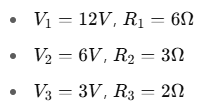🔌 Millman’s Theorem: A Shortcut to Solve Parallel Circuits
When you’re dealing with multiple voltage sources in parallel, things can get messy real quick. You could go node by node or apply superposition, but wouldn’t it be great if there was a faster way?
That’s where Millman’s Theorem comes in. It’s like a secret weapon for simplifying circuits that have multiple voltage sources connected in parallel. So, let’s dig in and make this tool a part of your electrical engineering arsenal.
🧠 What Is Millman’s Theorem?
Millman’s Theorem lets you find the voltage across multiple parallel branches with voltage sources and resistors. The core idea is to replace all those sources with a single equivalent voltage source and resistance.
Here’s the formula:

🔍 When to Use Millman’s Theorem?
Use it when you have multiple voltage sources in parallel, each with its own series resistance. It doesn’t work with current sources or non-linear components like diodes or transistors.
✅ Example 1: Beginner Level
Problem:
Find the voltage across the load connected to the following three branches:
- Branch 1: 10V with 5Ω
- Branch 2: 5V with 10Ω
- Branch 3: 0V (short to ground) with 20Ω
Solution:
Using Millman’s Theorem:

Numerator:

Denominator:

✅ Final Answer: 7.14V across the load
✅ Example 2: Intermediate Level
Problem:
You have three voltage sources connected in parallel:

Find the voltage across the common node using Millman’s Theorem.
Solution:
Apply the formula:

Numerator:

Denominator:

✅ Final Answer: 5.5V
✅ Example 3: Advanced Level
Problem:
You’re analyzing a circuit with four parallel branches, each containing a voltage source and resistor:

Find the equivalent voltage across the parallel network.
Solution:
Apply Millman’s Theorem:

Numerator:

Denominator:

✅ Final Answer: 5.6V across the output terminals
💡 Pro Tips for Using Millman’s Theorem
- Always check if all sources are connected in parallel—don’t apply Millman’s to mixed topologies.
- Voltage signs matter! If a source is reversed, plug in a negative voltage.
- Works only with independent voltage sources + resistors.
🧠 Why This Theorem Matters
If you’re studying for the theorem or taking any circuit theory exam, Millman’s Theorem can save you a lot of time. It simplifies complex parallel voltage source configurations to one simple calculation.
So instead of solving 3 equations with 3 unknowns, just plug into Millman and you’re done.
✅ Wrapping Up
Millman’s Theorem isn’t just a shortcut—it’s a powerful concept that makes you think in terms of equivalent systems. Once you get used to spotting those parallel voltage setups, this tool will become second nature.
Next time you see multiple voltage sources in parallel, don’t panic. Just Millman it.

Leave a Reply